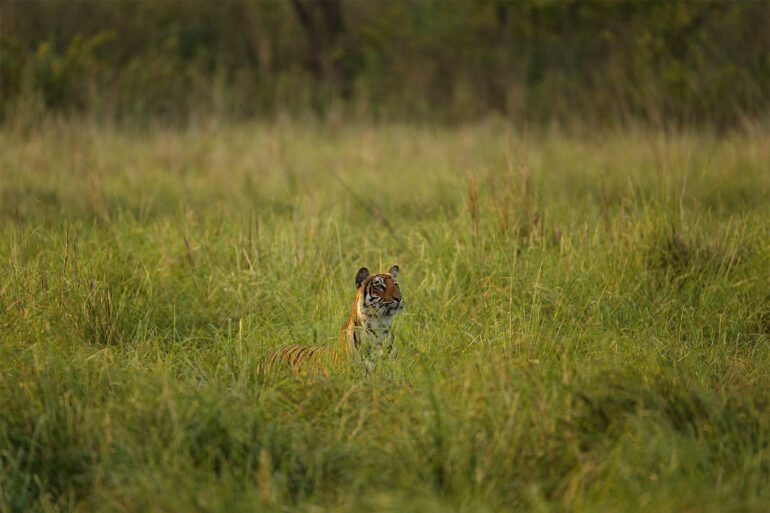TL;DR:
- Spotted deer are the favored prey of Nepal’s endangered tigers.
- Counting and monitoring these deer accurately is crucial for tiger conservation.
- Researchers from the University of Wageningen are using vertical cameras and AI algorithms to profile individual chittal based on their spots.
- The project faces challenges with a low image recapture rate and limited camera coverage.
- The AI model is being trained in the Netherlands using a similar species to refine its accuracy.
- The data will help implement sustainable management practices to balance prey and tiger populations.
- Nepal’s tiger population has seen significant growth, with 355 tigers in 2022.
Main AI News:
In the serene twilight hours, where tigers conceal their imposing shadows, a herd of spotted deer grazes peacefully, oblivious to the lurking peril. The slightest rustle in the nearby foliage prompts the herd to raise their heads, scanning for signs of danger before resuming their grazing, unaware of the impending threat.
Suddenly, a burst of raw energy propels the mighty feline out of concealment, executing a seamless attack on one of the deer. This animal, the favored prey of Nepal’s endangered tigers (Panthera tigris), stands no chance.
Such scenes are commonplace in Nepal’s Terai landscape, which is home to these endangered tigers. According to the Status of Tigers and Prey in Nepal 2022 report, spotted deer, known as “chittal” in Nepali, are the preferred prey species in the country. Diet analysis data reveals that nearly 50% of the tigers’ food comprises spotted deer (Axis axis) alone.
This intricate interplay between tigers and their prey underscores the critical importance of accurately monitoring the spotted deer population, including aspects such as age and sex. Yet, Nepali researchers face a formidable challenge due to the deer’s tendency to form herds and their similarity to other herbivores, such as barking deer (Muntiacus muntjak) and hog deer (A. porcinus).
However, a promising solution is on the horizon as researchers harness vertical cameras, enabling the identification of individual chittal based on their unique spots. Much like the profiling of individual tigers based on their fur patterns, a team of researchers from the University of Wageningen in the Netherlands is collecting vertical camera images of chittal and employing an algorithm for precise deer counting.
JF de Jong, a lecturer at the Wildlife Ecology & Conservation Group of Wageningen University, explained, “Horizontal cameras are primarily used for tiger counting in Nepal, and they excel at counting the relatively small tiger population. However, counting thousands of spotted deer presents a different challenge.”
Vertical cameras continuously capture images, with technicians replacing memory cards monthly. These images are then analyzed using an algorithm on a specialized wildlife camera trap image organization platform. Yet, the project faces a significant hurdle: a low image recapture rate, where individual chittal are often not detected again once initially identified.
Researchers propose two potential reasons for this phenomenon. First, the algorithm may struggle to differentiate between individual deer, as it lacks sufficient training data from the wild. Second, the limited coverage area of each camera—15 square meters (161.46 square feet)—may not capture images of all deer, even in a deployment of 50 cameras spanning 50 square kilometers (19.3 square miles).
To address these challenges, researchers are training their AI model in the Netherlands using fallow deer (Dama dama), a species similar to chittal. This training aims to refine the algorithm’s ability to detect individual members of the species accurately.
Additionally, researchers are exploring the use of drone images in conjunction with vertical cameras to enhance accuracy further. The refined algorithm will offer valuable data for conservation officials, enabling them to implement sustainable management practices that balance prey and tiger populations effectively.
JF de Jong remains optimistic, stating, “I am convinced that, just as we can profile tigers at an individual level, we can achieve the same for chittal.” Nevertheless, accuracy is paramount before the algorithm can influence Nepal’s tiger habitat management practices.
In 2010, Nepal committed to doubling its tiger population, which stood at 121 tigers. According to the latest census data, the country is now home to 355 tigers, demonstrating significant progress toward this ambitious goal.
Conclusion:
The integration of AI-powered deer tracking in Nepal’s tiger conservation efforts signifies a substantial step towards better managing and preserving these endangered species. This innovative approach has the potential to enhance wildlife management practices and contribute to the broader field of conservation technology.

